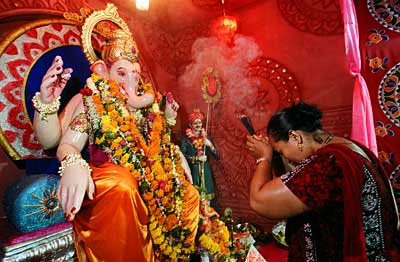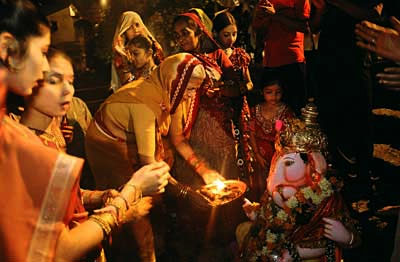aditi halbe

Since this essay is looking at a religious object whose sacredness is very individually understood and assimilated even for one who is not religious, in discussing this object, I will rely on the place of the deity in popular imagination. By this I refer specifically to its place in my imagination. Thus what follows, is the rendering of a single, individual interpretation of the sacred Ganesh.
ganesh's mythological origin
Like all gods in the Hindu pantheon, Ganesh has a mythological origin. He is the son of Shiva and his consort Parvati, both of human form and yet he bears the head of an elephant. The reason for this closely follows his birth or more appropriately his creation. He was not born to Parvati as mere mortal are. It is said that she was lonely. Shiva was away as was often the case. In her loneliness it appears she was given to neglect personal hygiene, or maybe it was an act of pure desperation and determination. She decided to create a child and did this by forming him, Ganesh, through moulding a substantial accumulation of her body dirt. And so Ganesh was born and Parvati was happy and occupied.

The story goes that one day, while Parvati was having a bath, Shiva came home. When he attempted to enter the house though, he was met with resistance in the form of the boy Ganesh. Neither of them knew they were related. Shiva got angry at not being allowed in and dealt with the situation by chopping off Ganesh’s head. It was at this moment that Parvati came out to find what Shiva had done. She was inconsolable but managed to tell Shiva that the boy whose head he had cut off was in fact his son. Angry and upset at the hash he had made of the situation, Shiva decided to fix it. He went out and hunted the first animal he saw, the elephant, and brought back its head to replace the boy’s. That is how Ganesh has an elephant head. He is worshipped as the remover of obstacles.
the ganesh festival
The reason I find the Ganesh deity an interesting object especially with regard to origin myths, is due to the close association between the Ganesh Festival and the state of Maharashtra in western India. The origin of this association can be traced back to the early days of the freedom struggle. In those days, Extremist members of the Indian National Congress Party, like B.G. Tilak, initiated the Samajik Utsav (public festival). The premise of this initiative was to use festivals as public forums in which to bring awareness and educate people about the freedom movement (Chandra, 1976). Tilak was from Maharashtra and is essentially said to have chosen the Ganesh Festival because it was one that was widely, privately celebrated.



It is a ten day festival that takes place in late August, early September to celebrate Ganesh’s birthday. There are a series of rituals performed and on the tenth day the deity is immersed into the sea. There is a big procession that takes place with much jubilation, where people come out in numbers carrying deities, sometimes as high as thirty feet to the sea. The materiality of this particular deity is an interesting one. Prior to the festival, there are a number of clay Ganesh deities that crowd market places. While people may worship Ganesh deities made of wood, silver or gold at home, for this festival they will also worship one made of clay so that it may be immersed. Only those Ganesh deities that are ritually worshipped are immersed. There then seems to be a level of inalienability that relates to the materiality of the deity itself. Aspects of this will be addressed in the sections that follow.
There are two reasons for the practice of immersion, though I am not able to tell which one is more popular or more accurate. It is said that he is immersed in order to send him back home to Mount Kailash. It is also said that the process of immersion is considered a proper way of disposing of the deity or rather a way of its safekeeping. Offerings in the form of flowers, given to the deity during rituals are disposed off in a similar fashion. This is because, in being offered to the deity during worship, these flowers imbue some sacred quality. Thus they cannot be carelessly discarded and are therefore appropriately tended to. This then raises questions about those qualities of water that make it an appropriate safekeeping medium for the sacred. But that is separate discussion that falls outside the purview of this discussion.


collecting the sacred
The consideration of the sacred within a Hindu context is open to multiple interpretations. In trying to make sense of Hinduism, I have always found it useful to view it as a religion made up of several strains of ideas that originate with a particular deity or one of its forms. There are a lot of ways in which the significance of the Ganesh deity and the history associated with it diverge and converge in different tellings of the object’s significance. There is no doubt that it is a sacred object because it is a representation of a god. They are widely collected. My mother collects them. She says she only does it because she finds them aesthetically pleasing and views them as artefacts. She has never used them as objects of worship though she has never thrown away a Ganesh given to her whatever its materiality and craftsmanship.

conclusion
In an attempt to bring together all the aspects of the Ganesh deity I have discussed and situate them within the theoretical framework I outlined to begin with, I would like to begi by considering Godelier’s relation of the foundation of society and the origin myth. Godelier says that the imaginary is essential for the construction of social reality and this reality cannot crystallise or reproduce itself without myth. It is this foundation myth that is at the core of the sacred object (Godelier, 1999). It is these ideas I feel are at work when the Ganesh deity is considered, but there is a difference in the way in which he talks about these ideas and the way that I want to apply them to this particular object. This is because he only examines the nature of the sacred as specifically corresponding with an origin of society.
The mythic origins of Ganesh as have been outlined earlier on in the essay, are not necessarily anchored in the social construct of a culture or society, but, if the use of the deity is considered within the historical/political sphere in terms of the festival, then there is an “acquired value” (to use Baudrillard’s term) that gets converted to the inherited value of the deity (Baudrillard, 1996). In this way this sacred object comes to be associated with a city-state identity, with a political-historical identity and through this with nostalgia.
Then going through the motions of the ritual tends to overshadow a person’s belief in the sacredness of the object. For example, perfoming the rituals and being present at the procession that leads to the immersion of the deity, becomes more important than questioning one’s personal relation to the sacred quality of the deity. A high value is placed on performance and there is a shift in the element of the sacred. To put it another way, when the supernatural origin is imagined for the social sphere, the social becomes sacred (Godelier, 1999). This is why I find the Ganesh deity such an interesting object, because it stars off as sacred in a very different way from Godelier’s idea about the sacred but eventually comes to stand for the sacred in the same way.bibliography
Baudrillard, Jean. 1996. The System of Objects. Verso: London, New York.
Chandra, Bipan. 1976. Modern India. National Council for Education Research and Training: Delhi
Godelier, Maurice. 1999. The Enigma of the Gift. The University of Chicago Press: Chicago.